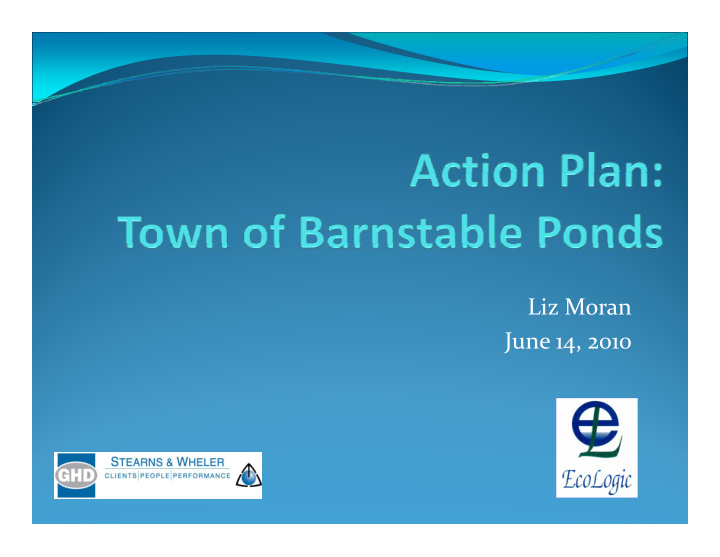



Liz Moran Liz Moran June 14, 2010
Overview Review assignment Ecology of inland kettle ponds Current status and trends Recommended actions
Scope of investigation Component of comprehensive nutrient management planning Identify underlying causes of water quality conditions Id if d l i f li di i Define potentially effective actions Town ‐ wide T id Pond ‐ specific Set priorities and outline implementation strategy Set priorities and outline implementation strategy
Kettle Pond ecosystems Glacial ice blocks Many lack surface inflows and outlets Groundwater seepage Nutrient accumulation
Eutrophication Nutrient enrichment ‐ process & effects Nitrogen and Phosphorus Thresholds for “impaired waters” Lovell’s Pond, with algal bloom July 2009 July 2009 Hamblin Pond: Recreational use
Lake and Pond Criteria Investigator/Program Total P Total N Chlorophyll ‐ a Secchi Disk (ug/l) (mg/l) (ug/l) (m) Carlson TSI Oligotrophic <6 ‐ 12 ND <0.95 ‐ 2.6 >8 ‐ 4 Mesotrophic 12 ‐ 24 ND 2.6 ‐ 7.3 4 ‐ 2 Eutrophic 24 ‐ 96 ND 7.3 ‐ 56 2 ‐ 0.5 Cape Cod: Ecoregional 9 0.41 6 2 (Reference conditions) ( ) Cape Cod: PALS Data 10 0.31 1.7 ND (Unimpacted threshold) ND= Not determined
Trophic State Ultra ‐ Shallow Ul Sh ll Sh ll Shallow D Deep Hathaway (South) Garrett’s Hamblin Oligotrophic Mary Dunn Joshua Hathaway (North) Mill (MM) Mill (MM) Micah Micah Red Lily Middle Neck Shubael Mesotrophic Aunt Betty’s Bearse Bog Coleman Lovell’s Fawcett No Bottom Mystic Lumbert Shallow Wequaquet Eutrophic Dunn’s Eagle Little/Stony Long (C’ville) Mill (WB) Long (MM) Muddy Muddy Parker Round (MM) Little Parker Schoolhouse Hypereutrophic
Summary of Use Attainment Water Quality and Aquatic Habitat Status Supports Desired Uses Currently Supports Does Not Depth Desired Uses, with Support Evidence of Desired Uses Categories: Categories: Degradation Ultra ‐ shallow Aunt Betty’s Red Lily Little Parker (less than 1.2 m Hathaway (South) Bog maximum depth) Lumbert Dunn’s Mary Dunn Fawcett Mill (MM) Little/Stony Mill (WB) Shallow Garrett’s Bearse Hinckley (from 2.1 to 8.6 m Joshua Coleman Long (C’ville) maximum depths) maximum depths) Eagle Eagle Long(MM) Long(MM) Muddy Muddy Elizabeth Parker No Bottom Schoolhouse Round (MM) Shallow D Deep Hathaway (North) H h (N h) Ch Chrystal l L Lovell’s ll’ (from 9.3 to 17.3 m Micah Hamblin maximum depths) Middle Mystic Neck Shubael Wequaquet
Build ‐ Out Analysis Assess the vulnerability of Barnstable ponds to future development How likely is increased nutrient loading? H lik l i i d i l di ? (zoning & land use changes) How might ponds react to increased loading? How might ponds react to increased loading? (current conditions & assimilative capacity)
Potential for Development Pond Watershed Percent Increase in Percent increase in Residential Units Commercial Square Ft Lovell 44 0 Indian 9 0 Mill 34 0 Bog Bog 27 27 330 330 Garrett 20 0 Wequaquet/Bearse/Shallow/ 8 39 Long Long Hinckley 24 0 Hathaway >100 821 Fawcett 17 146 Israel/Lamsom 0 290
Potential for Degradation Pond Watershed Current Conditions Vulnerability Lovell Impaired High Indian d a Supports uses Suppo ts uses Low ow Mill Supports uses Moderate Bog Supports uses Moderate G Garrett F ll Fully supports uses M d Moderate Wequaquet/Bearse/Shallow/ Long (CV) impaired, Moderate Long (CV) others support uses Hinckley kl Supports uses Moderate d Hathaway Supports uses Low Protected (Town) Fawcett Supports uses Moderate Israel/Lamsom Unknown Moderate
Priorities for Action: High Pond Status Recommendations Watershed BMPs; hand ‐ pulling, Little Parker H; Impacted; does not support benthic barriers desired uses Stormwater management, Hinckley E; Impacted septic inspections Priority for protection, Joshua O; At risk; Town beach, natural education, BMPs education BMPs vegetation; reference pond vegetation; reference pond indicative of pristine conditions Stormwater management, Long (Centerville) E; Impacted; Town beach, septic inspections, benthic p p , highly developed; Does not highly developed; Does not mats, hand ‐ pulling support desired uses Schoolhouse H; Impacted; does not support Stormwater management, desired uses septic inspections, benthic mats, hand ‐ pulling h d lli
Priorities for Action: High Pond Status Recommendations Monitor for effectiveness of alum O; At risk; Town Beach, Hamblin treatment; controls on future conservation land; alum ‐ treated; density and/or BMPs to minimize density and/or BMPs to minimize potential for increased residential potential for increased residential phosphorus migration development Continue acquisition of Hathaway (north) O; At risk; Town beach, mix of hydrologically important parcels in conservation land and watershed t h d development Priority for monitoring deep water M; Impacted; Town beach closed; Lovell’s phosphorus levels and N/P ratio; blue ‐ green algal bloom; does not consider nutrient inactivation support desired uses Priority for alum treatment M; Impacted/at risk; Public access, Mystic program; guide future development endangered mussels; permit phase to minimize surface runoff and for alum application; potential for groundwater nutrient input g p increased residential development p
Priorities for Action: High Pond Status Recommendations Priority for monitoring deep Michah O; At risk; Undeveloped, water phosphorus levels reference pond Priority for monitoring deep Middle O; At risk; Public access, water phosphorus levels; very clear consider acquisition of key parcels to control density
Recommended Actions Education Public forum on inland ponds Report card Monitoring ‐ three year rotation Local laws L l l Enhanced inspections & maintenance of on ‐ site systems Sediment & erosion control Sediment & erosion control Restoration Plan for alum treatment Plan for alum treatment
Questions and Discussion
Recommend
More recommend